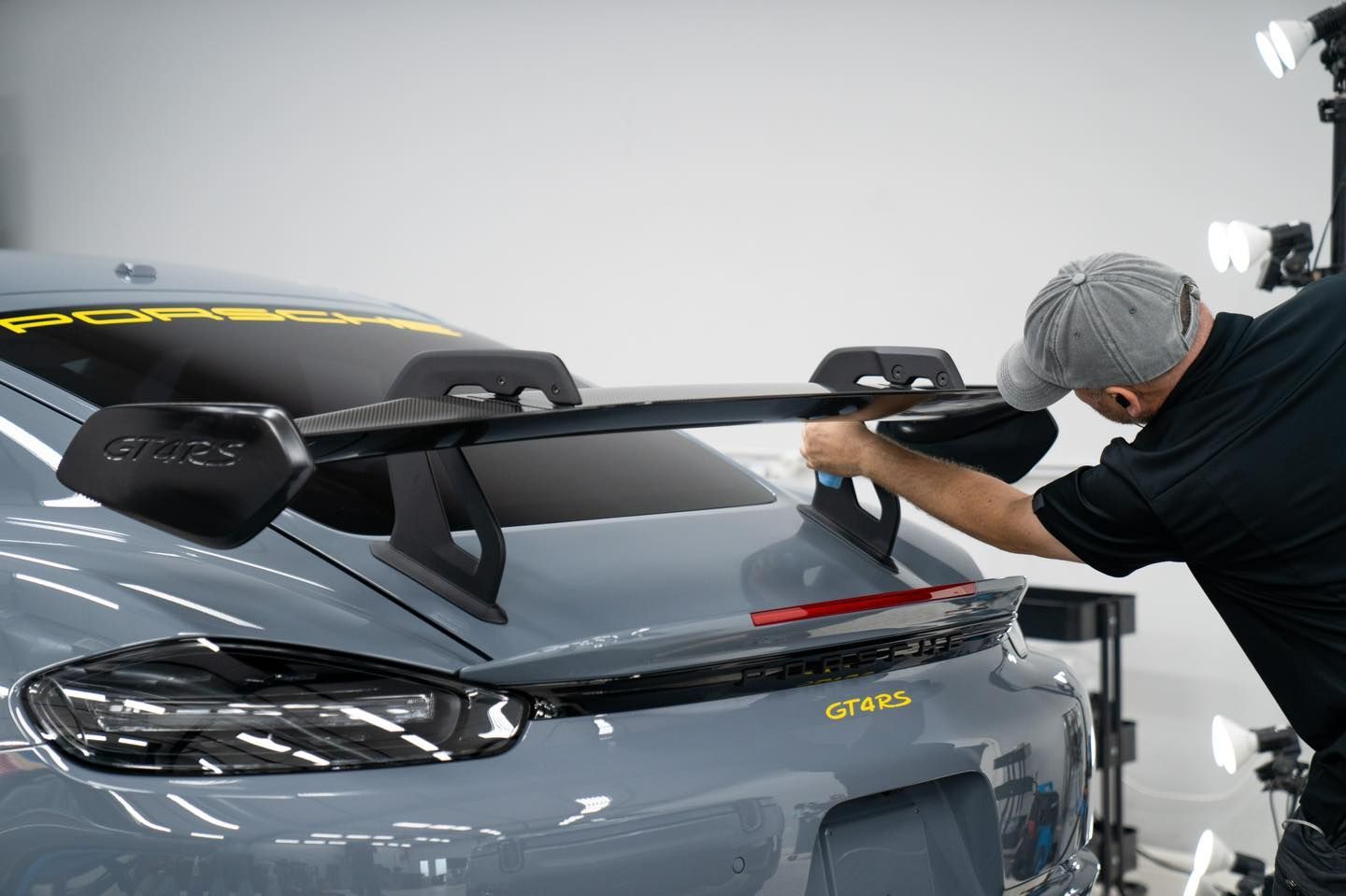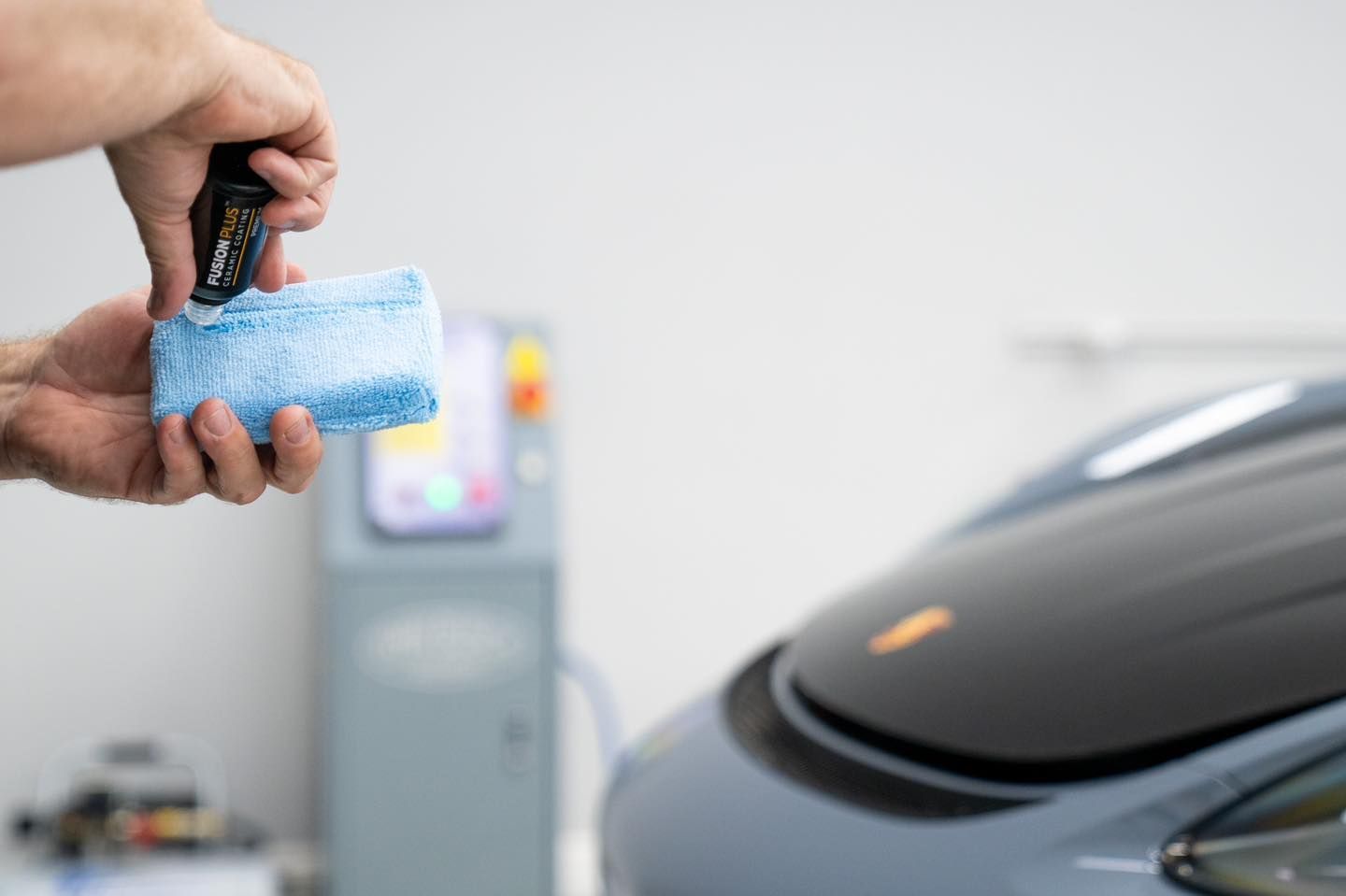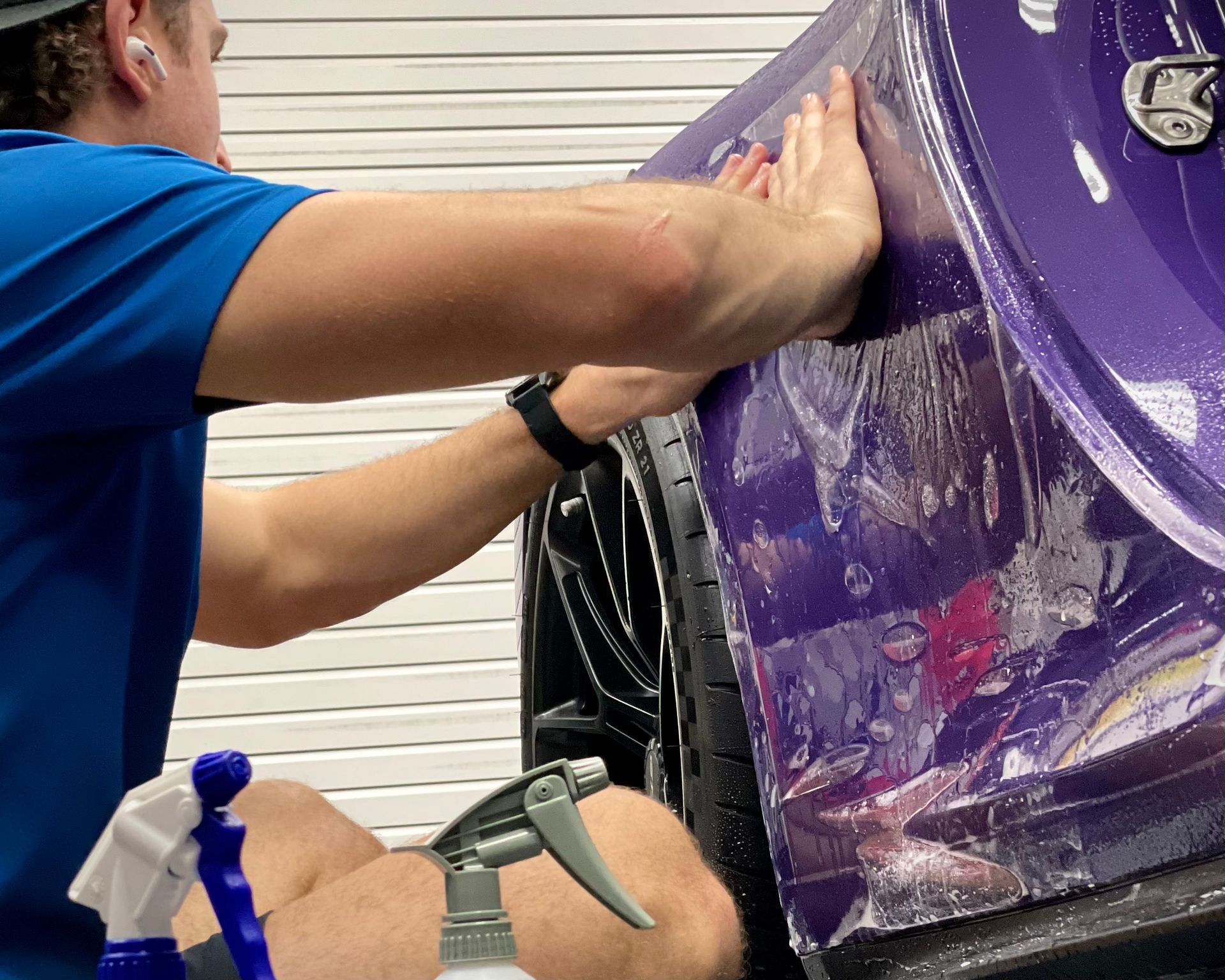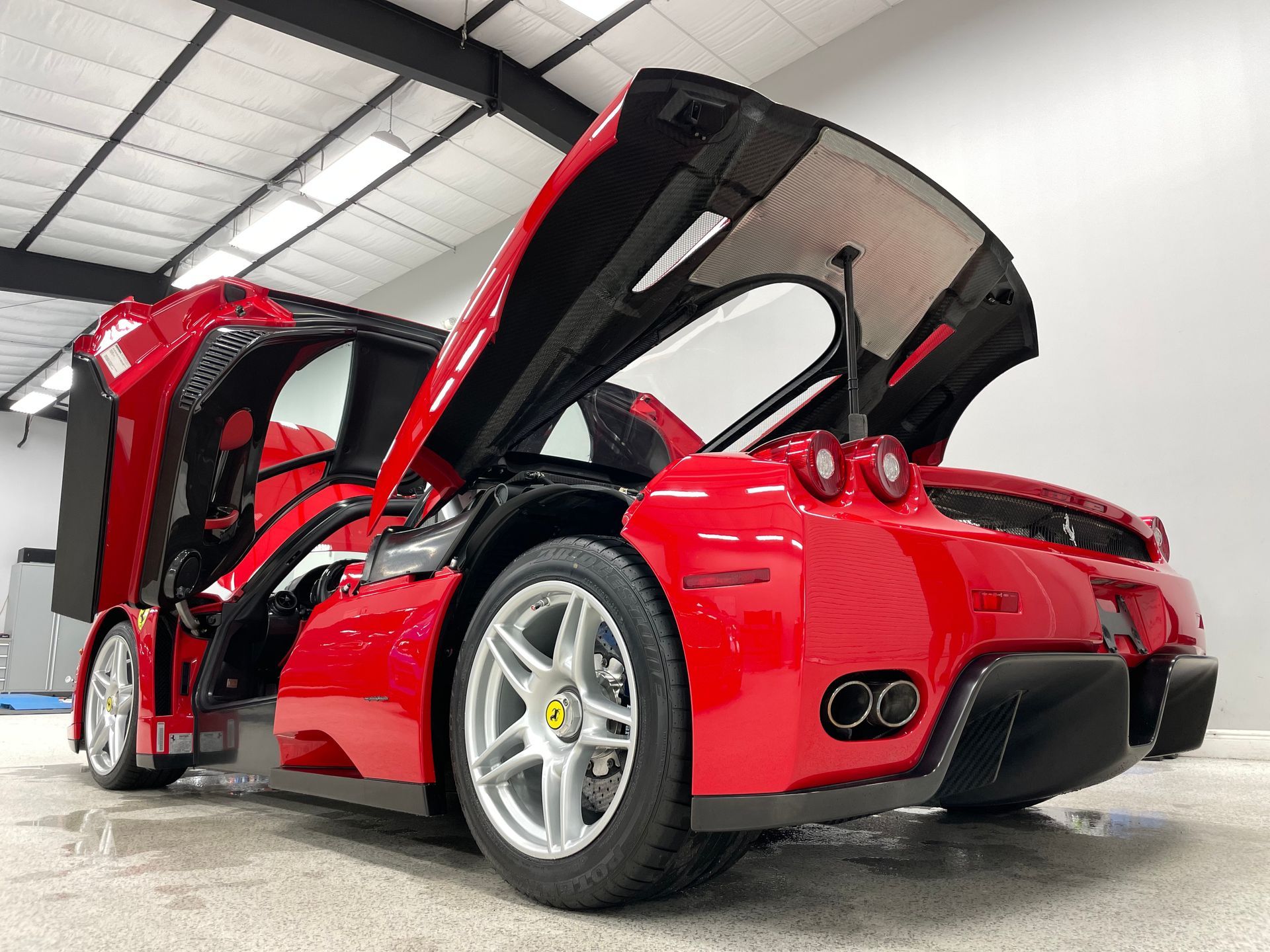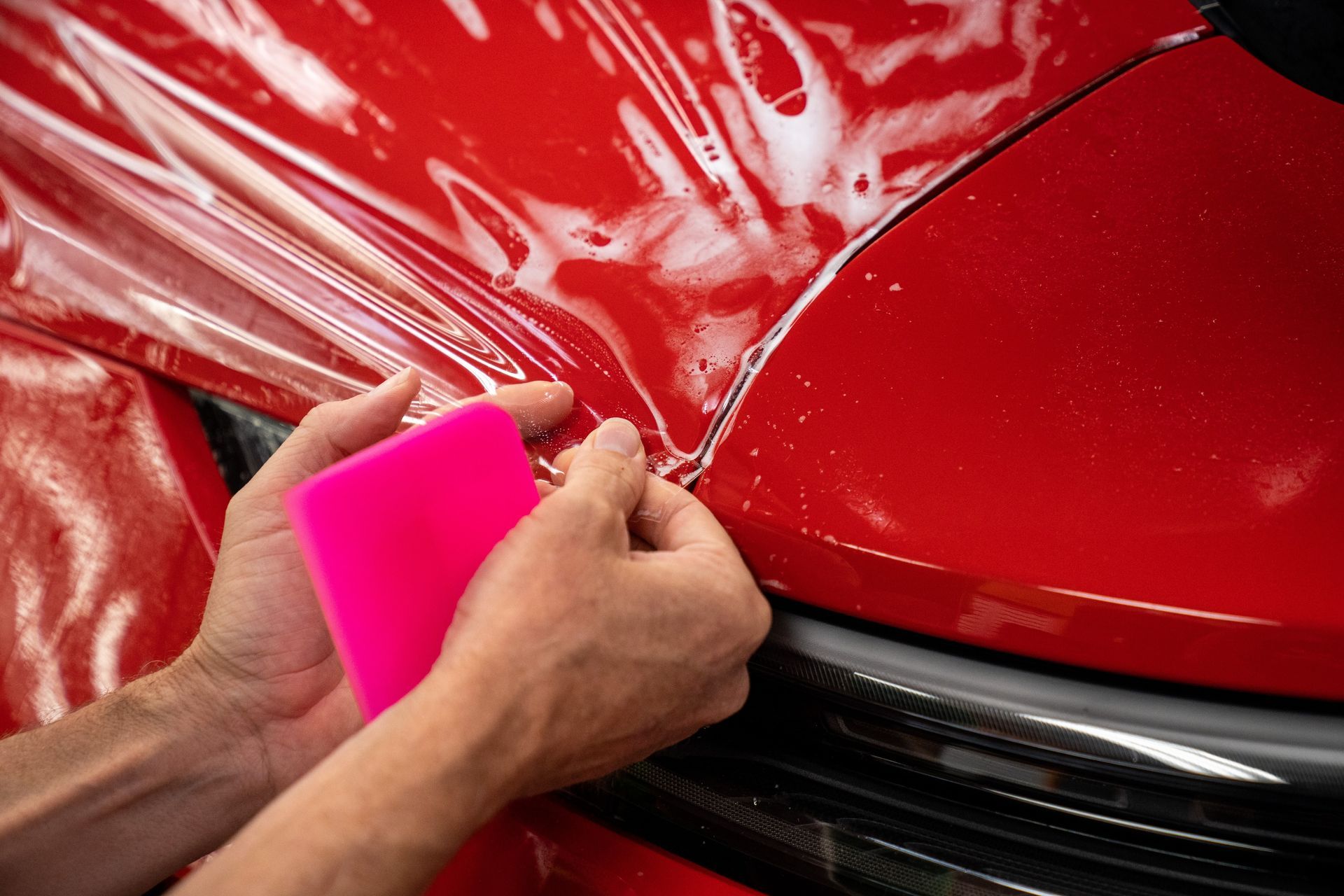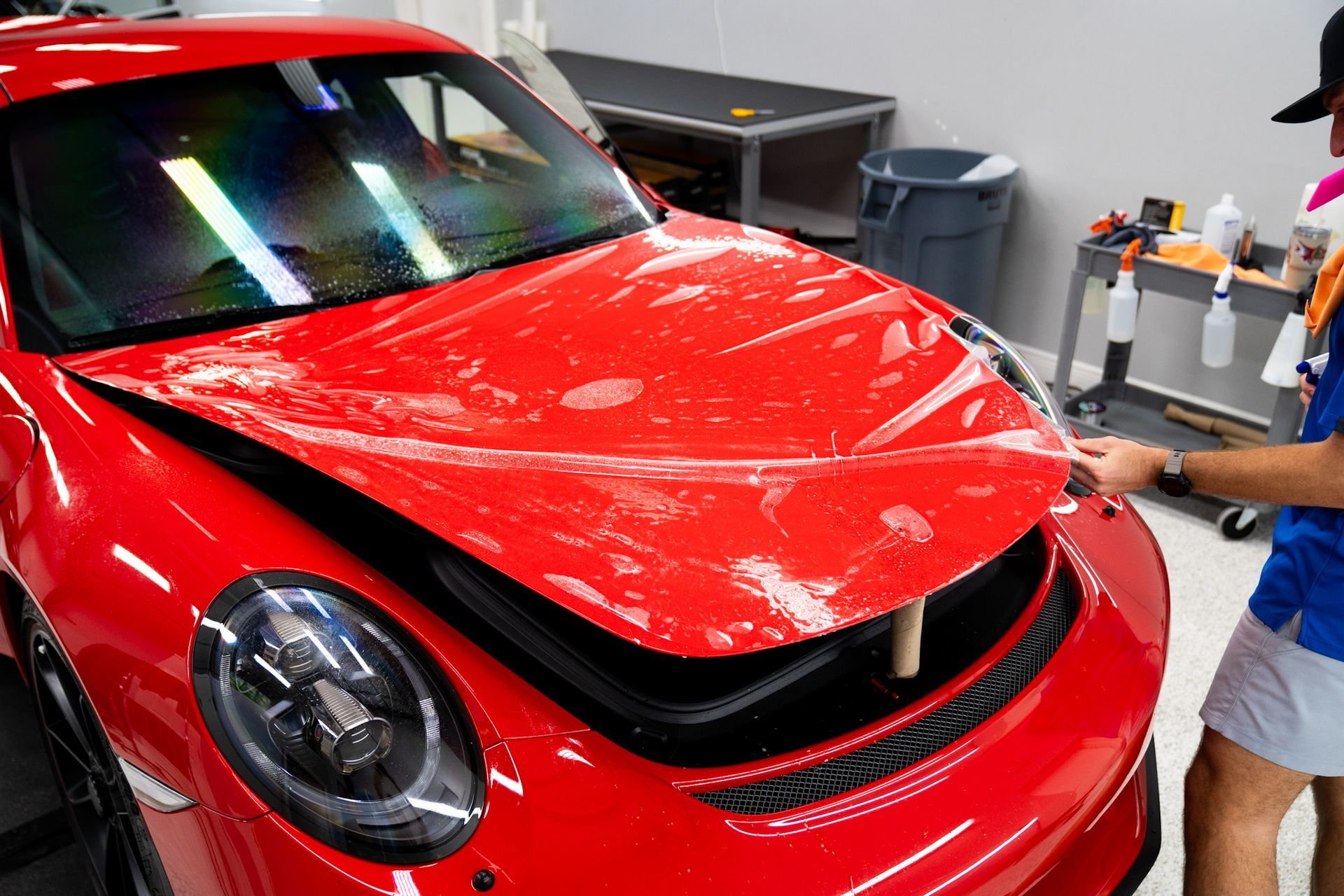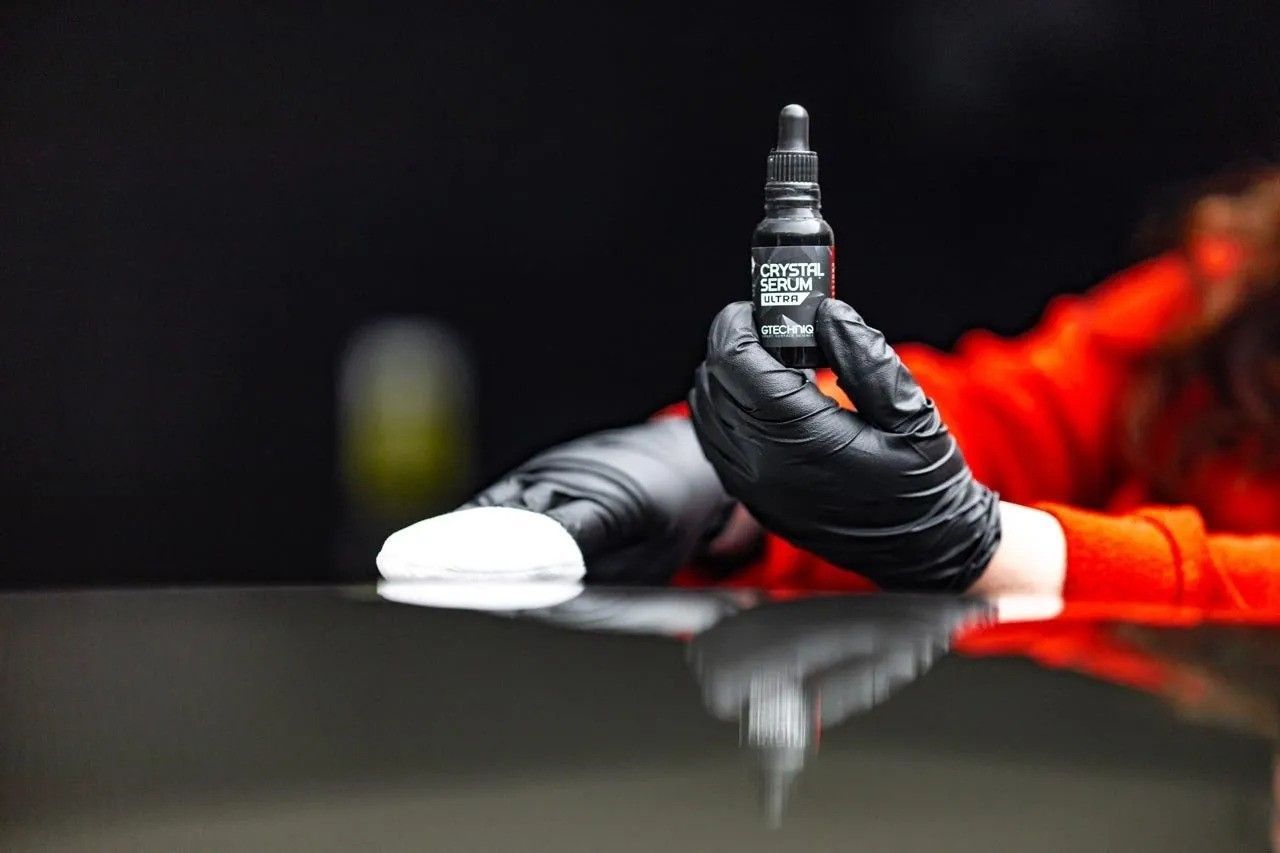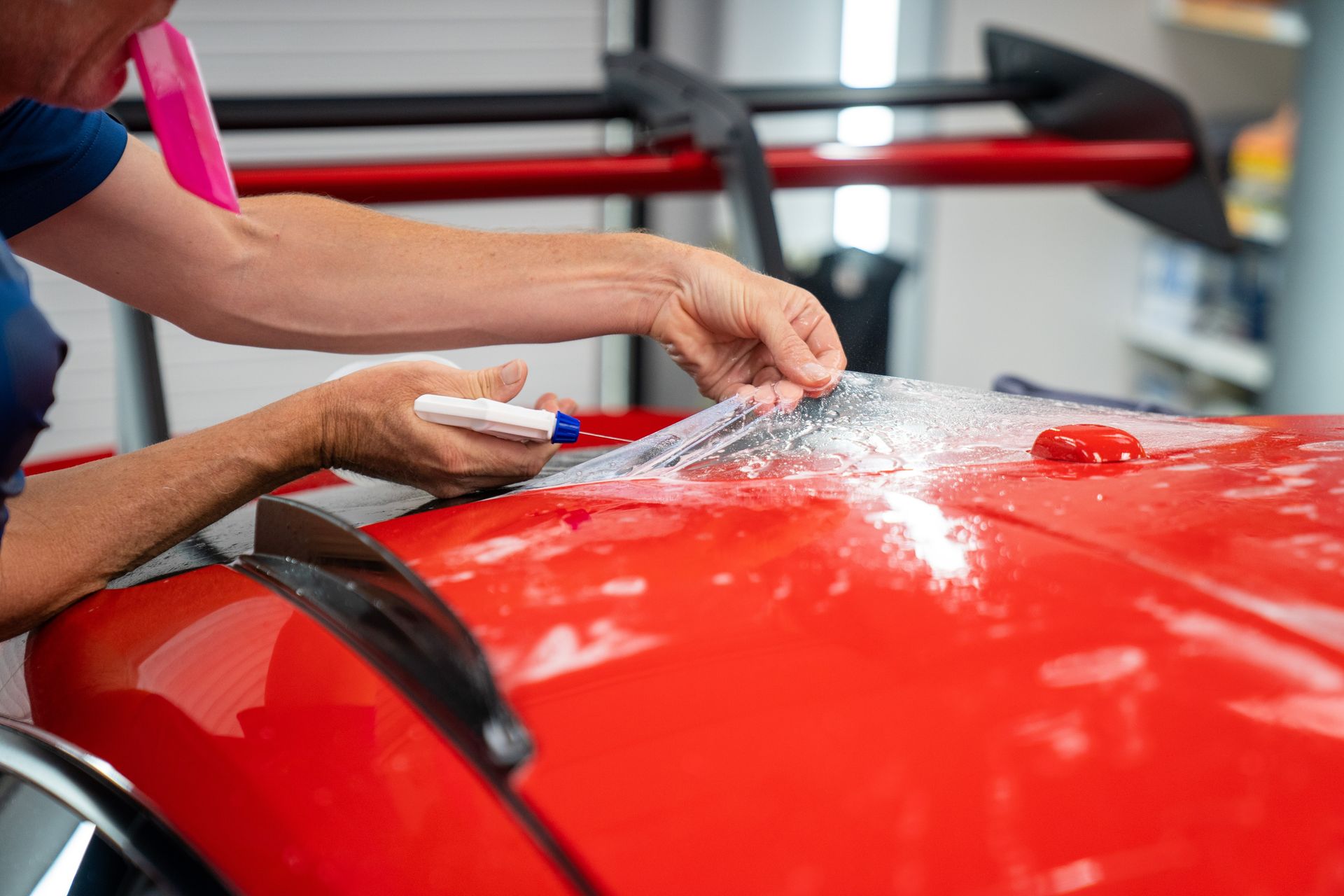Ceramic Coating and Automatic Car Washes: What’s Safe and What’s Not
CALL (813) 723-9679
GET A FREE ESTIMATEMaintaining your vehicle’s appearance requires proper washing methods, particularly when protective coatings like ceramic or paint protection film are applied. As vehicle owners weigh the convenience of automatic washes against the precision of manual cleaning, it becomes increasingly important to understand which practices preserve—rather than compromise—your vehicle’s finish.
While automatic car washes can be convenient, it is generally recommended to use touchless systems if your vehicle has ceramic coatings, as these methods significantly reduce the risk of surface damage. Always ensure that the wash facility maintains clean equipment to minimize any potential harm from dirt and debris.
Comparing Automatic and Manual Car Washes
The choice between automatic and manual car washes often comes down to convenience versus control. Automatic car washes provide speed and efficiency, making them a preferred choice for busy individuals seeking a quick and clean vehicle. You can drive in, get a full wash, and be back on the road in minutes. However, concerns arise with the use of rotating brushes or cloth strips that may carry debris, potentially compromising your vehicle’s finish over time. While protective coatings offer an added layer of defense, they aren't invulnerable to wear from repeated exposure. In contrast, manual washing allows for a more careful, hands-on approach, giving car owners the opportunity to gently clean their vehicles with greater attention to detail and reduced risk to the exterior surface.
Manual washing offers precise control and attention to detail, making it a preferred method for preserving your vehicle’s finish—especially when protective coatings are involved. Techniques such as the two-bucket method—one for rinsing and another for soapy water—help reduce the transfer of dirt particles, allowing for a more careful and controlled clean. Soft microfiber mitts further support this gentle approach, ensuring the vehicle is cleaned thoroughly without compromising its surface. Although manual washing requires more time, it provides better coverage, particularly in areas where dirt and residue tend to accumulate. For those committed to maintaining their vehicle’s appearance and long-term protection, manual washing remains the most reliable and paint-safe method.
What's Safe for Coated Cars?
For coated cars, ensuring a safe washing method is not just advisable—it’s necessary. The type of coating on your vehicle serves as its shield against environmental factors, and the right care can significantly prolong that protection. Understanding which washing techniques are most effective and least likely to damage that protective layer is crucial for every car owner.
Touchless Car Washes
Touchless car washes offer a safe alternative for coated vehicles by using high-pressure water and specialized detergents to clean without any physical contact. Without brushes or sponges, the process avoids unnecessary friction that could affect the surface over time. However, while effective for general cleaning, touchless systems may not fully remove tougher contaminants such as tree sap, bug residue, or bird droppings. For best results, pairing occasional touchless washes with periodic manual cleaning can help maintain the integrity and appearance of your vehicle. These systems rely on advanced sensors and software to navigate vehicle contours, delivering consistent, contact-free cleaning from multiple angles. While convenient, touchless washes are best viewed as a supplement to more thorough, hands-on maintenance when caring for coated surfaces.
Hand Washing with Soft Materials
Hand washing remains one of the safest and most effective methods for maintaining coated vehicles, especially when using soft microfiber mitts in combination with pH-neutral soaps. This combination ensures a gentle and controlled cleaning process that supports the longevity of protective coatings. The two-bucket method—one for soapy water and another for rinsing—helps minimize the transfer of dirt particles back onto the vehicle, promoting a cleaner finish. Using proper hand-washing techniques consistently helps preserve the surface, prevents buildup, and ensures the coating performs as intended. Regular washing not only maintains a clean, polished appearance but also extends the life of the coating, helping you protect your investment over time.
Common Risks and Damages
Even with the best intentions, washing a coated vehicle can present risks that may compromise its finish. Although mechanical brushes in automatic car washes may seem efficient, they can cause visible damage to the vehicle's surface and gradually wear down its protective layer. Similarly, harsh detergents with high pH levels, commonly used in these washes, are effective at removing dirt but can also degrade coatings over time, leading to a loss of gloss and protection. The use of improper tools—such as abrasive sponges or rough towels—can further impact the coating’s integrity, reducing its effectiveness and appearance. To avoid these pitfalls, it’s essential to use gentle, coating-safe products and proper washing techniques that preserve the vehicle’s surface while maintaining long-term protection.
Essential Maintenance Tips
One of the cornerstones of maintaining a ceramic-coated vehicle is regular washing. To prevent contaminants from building up, it's advisable to wash your car every two weeks. This proactive approach doesn't just keep your car looking pristine; it also safeguards the integrity of the coating itself. When choosing products, opt for dedicated car shampoos formulated with pH-neutral ingredients. Household detergents, although convenient, can be excessively harsh and lead to degradation of your precious ceramic coating over time. A key technique during washing is utilizing the two-bucket method, which involves one bucket for soapy water and another for rinsing your wash mitt. This routine minimizes the re-depositing of dirt onto the paint surface, thus preserving the coating's effectiveness during each wash cycle. It's akin to giving your vehicle a gentle spa treatment rather than an abrasive scrub.
Transitioning to another crucial aspect of upkeep is conducting regular inspections for any signs of damage or wear on the coating. Regular inspections allow you to catch issues early before they become more significant problems. After washing, take a moment to look for tiny scratches or swirls on the surface. If you find anything, this may indicate it’s time for patching or even a reapplication of the ceramic coating. Remember, the sooner you address these imperfections, the better. It’s similar to catching a small leak in a tire—if you ignore it, you'll end up needing a complete replacement later on. In addition to inspections, the environment where you wash your car plays a vital role in maintenance. Always make sure you're washing your vehicle in a shaded area. Direct sunlight can affect the cleaning agents' efficiency and often leads to unwanted water spots that mar the pristine appearance of your car once it dries. Think of it like baking a cake—if you place it in an overly hot oven, it won't rise properly; likewise, washing under direct sun can cause cleaning products to dry too quickly and leave residues behind. While it may be tempting to wash your car in bright sunlight while enjoying an iced drink, remember that shade plays a crucial role in maintaining the shine and effectiveness of your ceramic coating.
What's Safe for Coated Cars?
For coated cars, ensuring a safe washing method is not just advisable—it’s necessary. The type of coating on your vehicle serves as its shield against environmental factors, and the right care can significantly prolong that protection. Understanding which washing techniques are most effective and least likely to damage that protective layer is crucial for every car owner.
Touchless Car Washes
Touchless car washes offer a safe alternative for coated vehicles by using high-pressure water and specialized detergents to clean without any physical contact. Without brushes or sponges, the process avoids unnecessary friction that could affect the surface over time. However, while effective for general cleaning, touchless systems may not fully remove tougher contaminants such as tree sap, bug residue, or bird droppings. For best results, pairing occasional touchless washes with periodic manual cleaning can help maintain the integrity and appearance of your vehicle. These systems rely on advanced sensors and software to navigate vehicle contours, delivering consistent, contact-free cleaning from multiple angles. While convenient, touchless washes are best viewed as a supplement to more thorough, hands-on maintenance when caring for coated surfaces.
Hand Washing with Soft Materials
Hand washing remains one of the safest and most effective methods for maintaining coated vehicles, especially when using soft microfiber mitts in combination with pH-neutral soaps. This combination ensures a gentle and controlled cleaning process that supports the longevity of protective coatings. The two-bucket method—one for soapy water and another for rinsing—helps minimize the transfer of dirt particles back onto the vehicle, promoting a cleaner finish. Using proper hand-washing techniques consistently helps preserve the surface, prevents buildup, and ensures the coating performs as intended. Regular washing not only maintains a clean, polished appearance but also extends the life of the coating, helping you protect your investment over time.
Common Risks and Damages
Even with the best intentions, washing a coated vehicle can present risks that may compromise its finish. Although mechanical brushes in automatic car washes may seem efficient, they can cause visible damage to the vehicle's surface and gradually wear down its protective layer. Similarly, harsh detergents with high pH levels, commonly used in these washes, are effective at removing dirt but can also degrade coatings over time, leading to a loss of gloss and protection. The use of improper tools—such as abrasive sponges or rough towels—can further impact the coating’s integrity, reducing its effectiveness and appearance. To avoid these pitfalls, it’s essential to use gentle, coating-safe products and proper washing techniques that preserve the vehicle’s surface while maintaining long-term protection.
Essential Maintenance Tips
One of the cornerstones of maintaining a ceramic-coated vehicle is regular washing. To prevent contaminants from building up, it's advisable to wash your car every two weeks. This proactive approach doesn't just keep your car looking pristine; it also safeguards the integrity of the coating itself. When choosing products, opt for dedicated car shampoos formulated with pH-neutral ingredients. Household detergents, although convenient, can be excessively harsh and lead to degradation of your precious ceramic coating over time. A key technique during washing is utilizing the two-bucket method, which involves one bucket for soapy water and another for rinsing your wash mitt. This routine minimizes the re-depositing of dirt onto the paint surface, thus preserving the coating's effectiveness during each wash cycle. It's akin to giving your vehicle a gentle spa treatment rather than an abrasive scrub.
Transitioning to another crucial aspect of upkeep is conducting regular inspections for any signs of damage or wear on the coating. Regular inspections allow you to catch issues early before they become more significant problems. After washing, take a moment to look for tiny scratches or swirls on the surface. If you find anything, this may indicate it’s time for patching or even a reapplication of the ceramic coating. Remember, the sooner you address these imperfections, the better. It’s similar to catching a small leak in a tire—if you ignore it, you'll end up needing a complete replacement later on. In addition to inspections, the environment where you wash your car plays a vital role in maintenance. Always make sure you're washing your vehicle in a shaded area. Direct sunlight can affect the cleaning agents' efficiency and often leads to unwanted water spots that mar the pristine appearance of your car once it dries. Think of it like baking a cake—if you place it in an overly hot oven, it won't rise properly; likewise, washing under direct sun can cause cleaning products to dry too quickly and leave residues behind. While it may be tempting to wash your car in bright sunlight while enjoying an iced drink, remember that shade plays a crucial role in maintaining the shine and effectiveness of your ceramic coating.
Expert Recommendations
One of the best actions you can take is to follow recommendations from industry professionals. Such methods prevent potential scratching that brushes can inflict on your car’s delicate surface. A few minutes of thoughtful care during a wash can preserve that mirror-like finish of your vehicle for years. Using pH-neutral products is another essential tip. These detergents maintain the integrity of ceramic coatings without stripping away their protective elements. Remember, harsh chemicals can deteriorate both the coating and the paint beneath, leading to disappointment quicker than you might imagine. Think of using pH-neutral products as a gentle hug for your car's exterior—nurturing and protective. Many detailers also recommend scheduling regular inspections alongside your washing routine. This approach ensures that any minor issues are detected and addressed before they escalate into more significant problems. Not only does this safeguard your investment, but it helps sustain that like-new brilliance over time.
For convenience, consider professional detailing services that provide tailored maintenance packages for vehicles with ceramic coatings. Investing in these services allows you to relax while experienced hands take care of meticulous upkeep. Engaging a professional ensures that your vehicle receives treatments specifically designed for its protective layers. Finally, maintaining your car’s clean appearance goes beyond just cleaning. Aftercare requirements must be part of your plan. Following guidelines provided by manufacturers will empower you to get the most out of your ceramic coating investment. It might feel like added work initially, but understanding how to maintain these products properly pays off significantly in longevity and aesthetic appeal.
In summary, making informed choices and incorporating expert recommendations into your washing and maintenance routines will yield lasting results—and give you plenty of reasons to admire your impressive vehicle every time you catch a glimpse in the reflection. Ultimately, ensuring proper care for your vehicle’s finish enhances its appearance and protects your investment for years to come.
Leading Ceramic Coating Services in Clearwater, FL
Give your vehicle the protection it deserves with Presidential Automotive Detailing’s
premium ceramic coating services
in Clearwater, FL. Our expert team applies industry-leading coatings that shield against UV rays, environmental contaminants, and daily wear—keeping your paint glossy, smooth, and easier to maintain. Whether you're safeguarding a new purchase or enhancing a trusted daily driver, our ceramic solutions are tailored for long-term performance and visual impact.
Schedule your appointment today and experience the difference precision protection can make!

